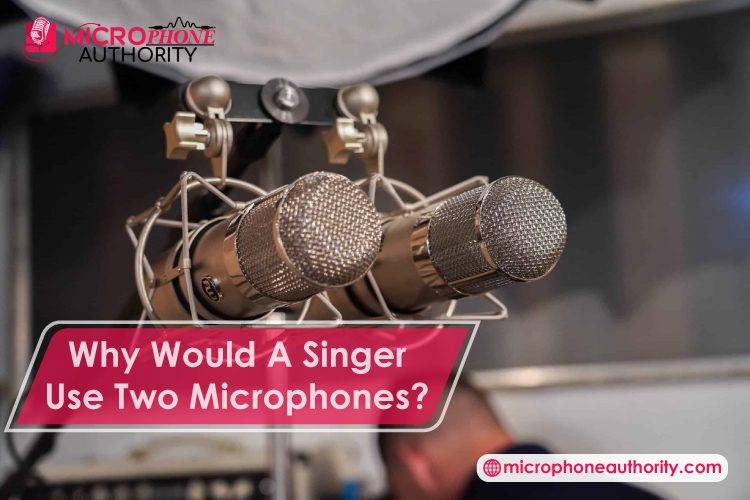Last Updated on April 7, 2023 by Robert Mejia
The use of two microphones was a common practice back in the 1970s. The recording people would tape a second mic to the public address vocal microphone to obtain their feed while recording live concerts.
Back then, microphone splitters were not reliable and were also expensive. A microphone splitter is a device with input from a mic but with multiple outputs. Splitters send microphone signals to two distinct recording systems.
However, there are many affordable and dependable splitters today, and they are convenient devices for recording signals from one mic to different outputs.
So, you might wonder why a singer would use two microphones while performing in concerts or recording their vocals.
Based on my extensive research and observation, singers may prefer to use two microphones for several reasons. Let’s talk about a few of them:
1) To Create Different Moods For A Song
Different microphones come with different features, and it’s possible to create certain moods for a song by fine-tuning the sound.
Singers may use two mics with different characteristics to fine-tune the sound. One mic can be a condenser and the other one a dynamic, or even the same type with different properties.
A condenser mic will do great with softer parts of the song while a dynamic produces an excellent voice for the screamy parts.
Some singers may also use two different microphones when recording acoustic guitars and other instruments like drum kits. You are likely to see this more in studios than in live performances.
If you would like to try this combination, find a good dynamic mic to capture a wide array of dynamics, and you might like it!
2) To Enhance Flexibility When Mixing
When singing into two different microphones, the texture of two distinct tones will improve the mixing flexibility. Of course, this happens only when you use two different mics.
Identical mics will have no better results than using one microphone.
Although it may seem unnecessary, varied tones in your audio leads to a lot of flexibility at the mixdown process.
3) Using Two Microphones For Noise Cancellation
The idea of using two mics to cancel ambient noise is well-known and popular in many sound applications. It was very common with the Grateful Dead Rock Music Band.
Most aircraft communication headsets consist of two microphones for noise cancellation. One faces the user, and the other one faces outwards to attenuate any active noise to ensure that the recipient will clearly hear what’s being said.
Similarly, a singer may want to use two microphones to reduce the effects of residual noise during the performance.
When you are singing to a noisy crowd, you might struggle to be heard. The noise from the audience may also make your voice sound bad.
Luckily, two omnidirectional mics can be set up in a way that one is a few inches away from the singer’s mouth than the other.
How The Noise Cancellation Works
When singing with two mics, singers normally use omnidirectional mics to help with noise cancellation.
The Omni mics are placed just a few inches away from each other, ensuring that one is nearer to the sound source (the singer’s mouth) than the other.
The two mics will collect the ambient noise equally, but the front microphone will receive significantly more energy from the sound source.
By combining the two identical levels of ambient noise signals, silence is achieved.
Although there is always a slight reduction of the wanted sound, this side effect is worth suffering, given that the ambient noise will be canceled.
Final Thoughts
While the use of two microphones has nothing to do with the quality a mic produces, it is effective with noise cancellation when singing or recording in a less quiet environment.
This technique can help you create different moods for a song or fine-tune the sound.
Besides, the use of two microphones can help you achieve a particular sound that you have been looking for, and you won’t find using a single type of mic.
So, why don’t you try out something new and see how it will work for you? By the end of the day, you might realize that it’s a unique way to get a full sound for your vocal.





